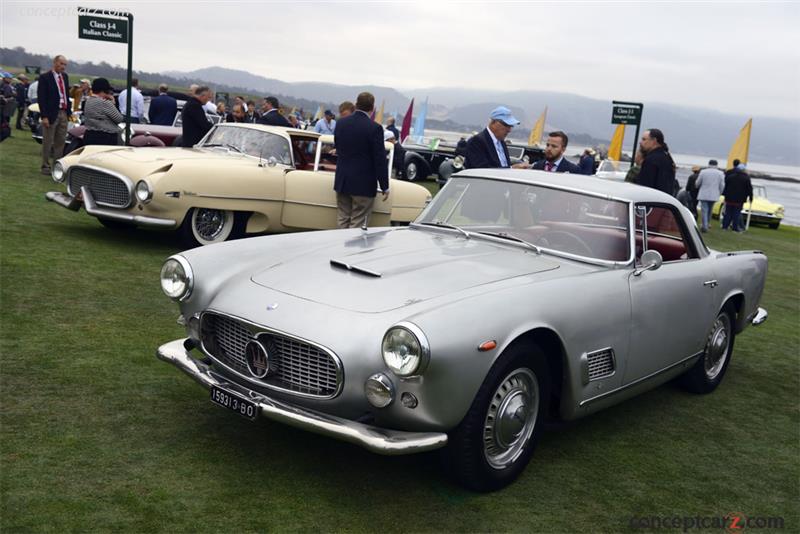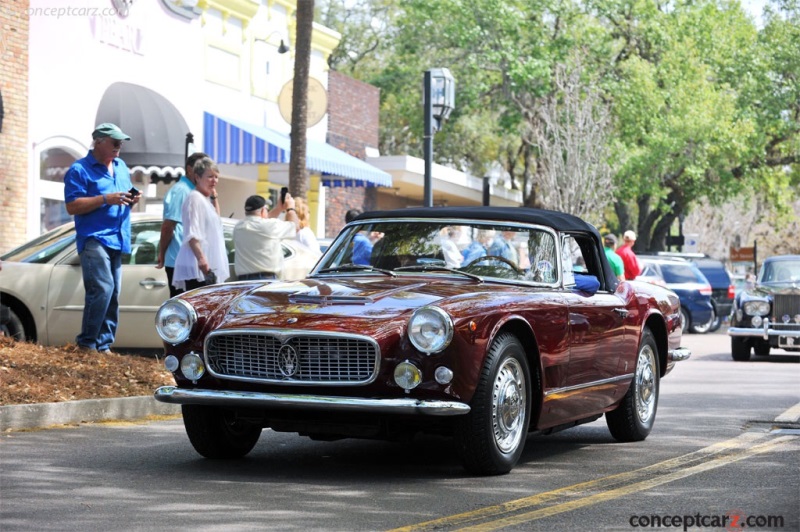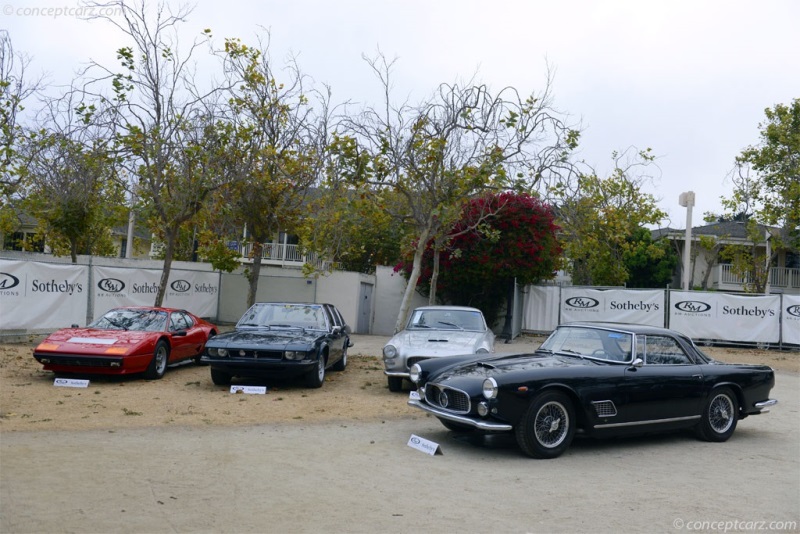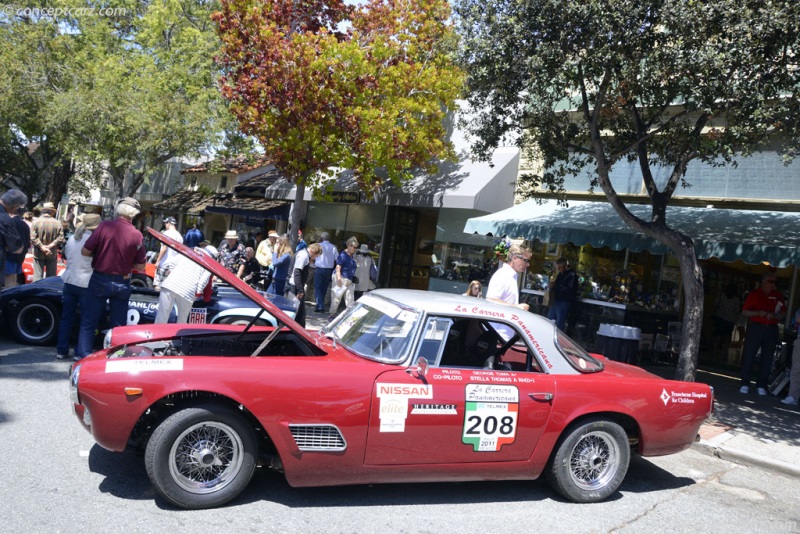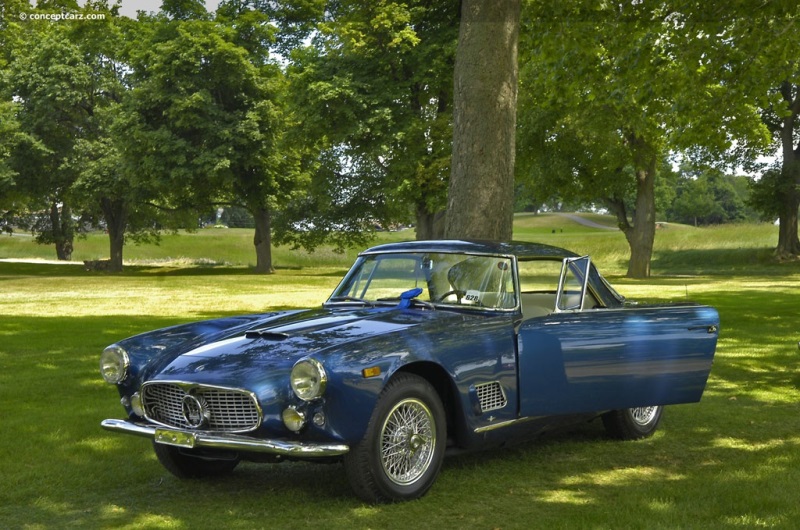1961 Maserati 3500 GT Navigation
The Maserati 3500 GT was the company's first true series-production road model and during its production lifespan, lasing from 1958 to 1964, as few as 2,223 examples were built. Engineering was by Giulio Alfieri, the styling was courtesy of Giovanni Michelotti, the open Spider coachwork was courtesy of Vignale, and the Superleggera (Super Light) Coupe was by Touring. Most were equipped with Weber carburetors and later examples received Lucas fuel injection. 
Coupe by Vignale
View info and historyDuring the 1950s, particularly in 1957, Maserati enjoyed numerous racetrack successes that included Juan Manuel Fangio's fifth World Championship while driving a 250F, and the runner-up spot in the World Sports Car Championship with the 450S. Despite a stellar year of motorsport, the company was in a precarious financial situation. Political unrest in Argentina, a country in which Maserati's parent company was heavily invested, promptly dried up the marque's wealth, forcing its withdrawal from racing. Maserati's survival strategy for the 1960s centered on establishing the company as a producer of road cars. That new era began with the introduction of the Touring-bodied 3500GT, its first road car built in significant numbers.The Maserati 3500GT was a luxurious '2+2' that drew heavily on the company's competition experience, employing a tubular chassis frame and an engine derived from the 350S competition sports car unit of 1956. The suspension was independent at the front by wishbones and coil springs while at the back there was a conventional live axle/semi-elliptic arrangement. Chief engineer Giulio Alfieri was the creator of the immortal Tipo 60/61 'Birdcage' sports-racer and the man responsible for developing the 250F into a World Championship winner. He was also the individual tasked with designing the 3500GT into a comfortable, elegant, higher-volume Gran Turismo. The frame was constructed from tubes of square, round or elliptic section of 'Superleggera' construction employing double wishbones and coil springs in the front while the rear used a Salisbury solid axle on semi-elliptic leaf springs. Hydraulic dampers and anti-roll bars were used at all four corners. This sturdy chassis design would be in use through the Sebring and Mistral models at the end of the 1960s. 
Coupe by VignaleThe steering was courtesy of a recirculating ball type and stopping power was by hydraulic 12-inch Girling finned drum brakes. Disc brakes were later introduced on the front wheels, and finally on all four. The 16-inch steel disc wheels were initially wrapped with Pirelli Stella Bianca tires, and later Pirelli Cinturato radial-ply tires. Wider 185x16 radial tires were optional, as were Borrani knock-off wire wheels. The 3.5-liter twin-spark, twin-overhead-camshaft, 12-valve straight six-cylinder engine of the Maserati 350S was modified with wet-sump lubrication and tuned to be more refined and tractable for road use. It had a bore and stroke of 86 mm x 100 mm, displaced 3,485.29cc, and breathed through three twin-choke 42 DCOE Weber carburetors. The engine block was formed from lightweight aluminum, was aluminum cylinder heads, cast iron valve seats, cast iron cylinder sleeves, and hemispherical combustion chambers. Initially, it developed around 220 horsepower at 5,500 while later examples produced 235 horsepower on Lucas mechanical fuel injection. Built initially with a four-speed (ZF S4-17) transmission, the 3500GT was progressively updated, gaining five speeds (ZF S5-17), front disc brakes, and, finally, all-disc braking before production ceased in 1964. The transmission used a hydraulically actuated Borg & Beck single-plate dry clutch.Zero-to-sixty mph was accomplished in approximately eight seconds and top speed was achieved at 140 mph. 
Coupe by VignaleWhile the lion's share of high-waisted coachwork was created by Touring using its signature Superleggera lightweight construction technique, its advanced chassis attracted the attention of Italy's finest carrozeria including Bertone, Frua, and Allemano. Most coupes were the work of Touring, while all but one - a Frua-bodied example - were of the much less common spyder version were the work of Carrozzeria Vignale. Introduced in 1959, the Spyder was designed by Maserati's designer, Giovanni Michelotti, and built atop a slightly shorter wheelbase - 250cm as opposed to 260cm - than the coupe and constructed of steel panels rather than the closed car's aluminum. Production of the spyder lasted until 1964, by which time 245 examples had been made. Pietro Frua's Carrozzeria Turin created elegant but audacious coachwork on the Maserati chassis during the 1960s, mostly for the 5000GT. Each 5000 GT was a bespoke, tailored automobile, and it is only fitting that Frua's unique designs on those chassis would inspire special creations for other Maserati products as well. In 1961, Frua created two similar bodies for the 3500 GT (chassis AM101.1496 and AM101.1494), with smooth, sleek side panels, curved only by a crease at the beltline, and connected by a graceful tail. The quad headlamps were set in a custom-designed bezel, and a thin wraparound bumper complemented the aggressive nose with a deep inset. Delicate chrome accents accentuated the fine details of the vehicle throughout the interior and exterior. Later, around 1963, Frua built two more cars to a similar design in the fuel-injected 3500 GTi series. Carrozzeria Allemano bodied four coupes including the 1957 prototype, Pietro Frua bodied two or three coupes and one spider, and Carrozzeria Boneschi bodied a coupe to a design of Rodolfo Bonetto which was shown at the Turin Motor Show in 1962 and at the Geneva Motor Show in 1963. Franco Scaglione created a design that was executed by Bertone and put on display at the 1959 Turin Motor Show. In 1966, Moretti built a coupe for the Geneva Motor Show.
Coupe by VignaleUnveiled for the first time at the 1957 Geneva Auto Show, Maserati's 3500 GT held the monumental task of determining the fate of the company. The approach to its mechanical design was to stick with conventional techniques, incorporating a chassis and suspension structure similar to its predecessor, the AG6/54, as they were composed of large-diameter steel tubes with sheet-steel stiffeners. The detuned twin-cam inline-six-cylinder engine sourced from the 350S was potent but civilized, retaining the inherent raciness of its predecessor. Designed for long, cross-continental journeys, the cabin was airy and relaxed, with delicate yet easily legible dials, a sculpted dash, a short-throw shifter, and wide, comfortable seats. The coach-built bodies combined both sporty and elegant personas, with just the right amount of chrome and brightwork to accent the bodylines. With over 2,200 examples built, it provided Maserati with the financial stability to regain its footing, while the Maserati 5000 GT (built from 1959 to 1966 with just 34 examples built) reminded all that the company was capable of building exclusive, potent, and bespoke vehicles that ranked among the best in the world.When Maserati ended the 3500 GTi in 1964, it was replaced by the Sebring 2+2 which was built from 1962 through 1969 with 593 examples created. Its 'Sebring' name was in reference to its victory at the 12 Hours of Sebring in 1957 and its intended market - America. It used the company's Tipo AM101 inline-6 engine with a 3,485cc displacement size and Lucas fuel injection, backed by a ZF 5-speed manual or optional Borg-Warner 3-speed automatic. The wheelbase measured 98.4-inches - the same as the spyder.
by Daniel Vaughan | Nov 2016
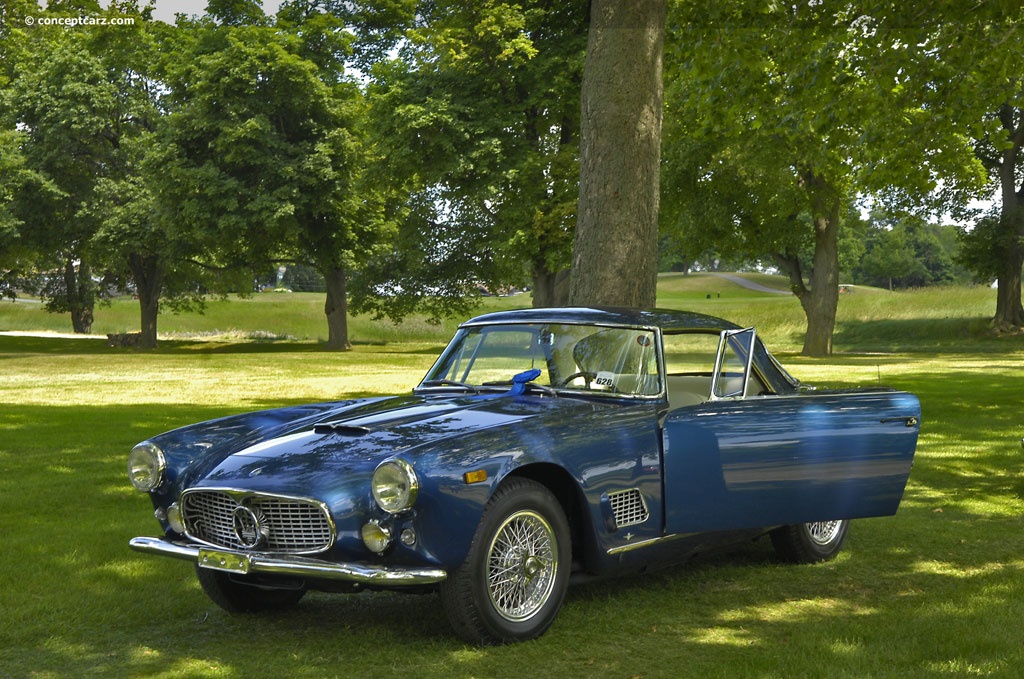
Coupe by Vignale
View info and history

Coupe by Vignale
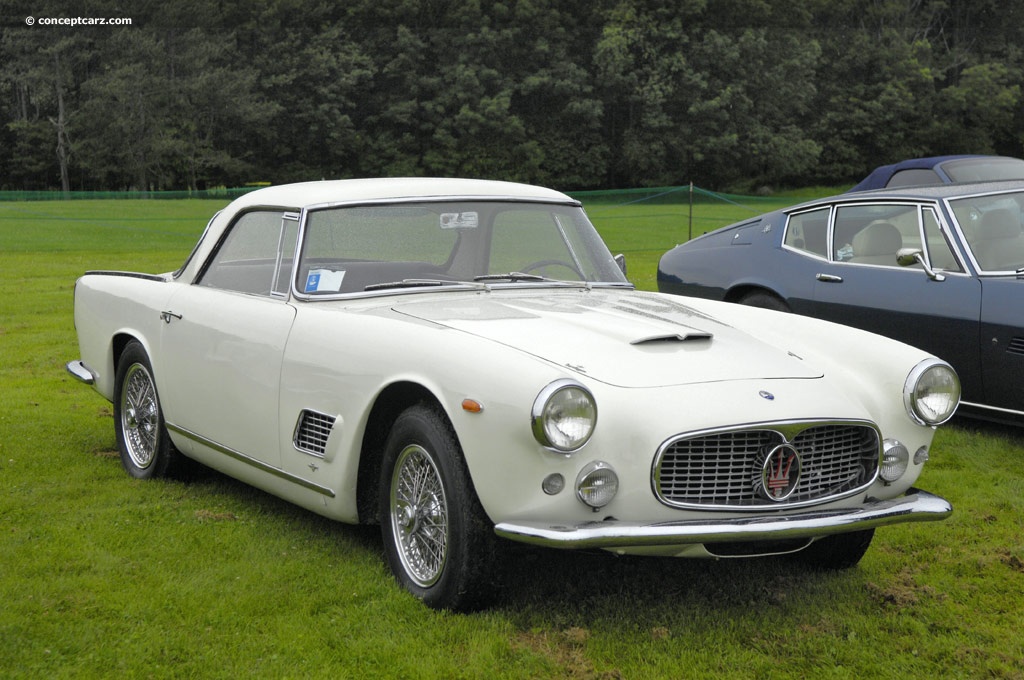
Coupe by Vignale
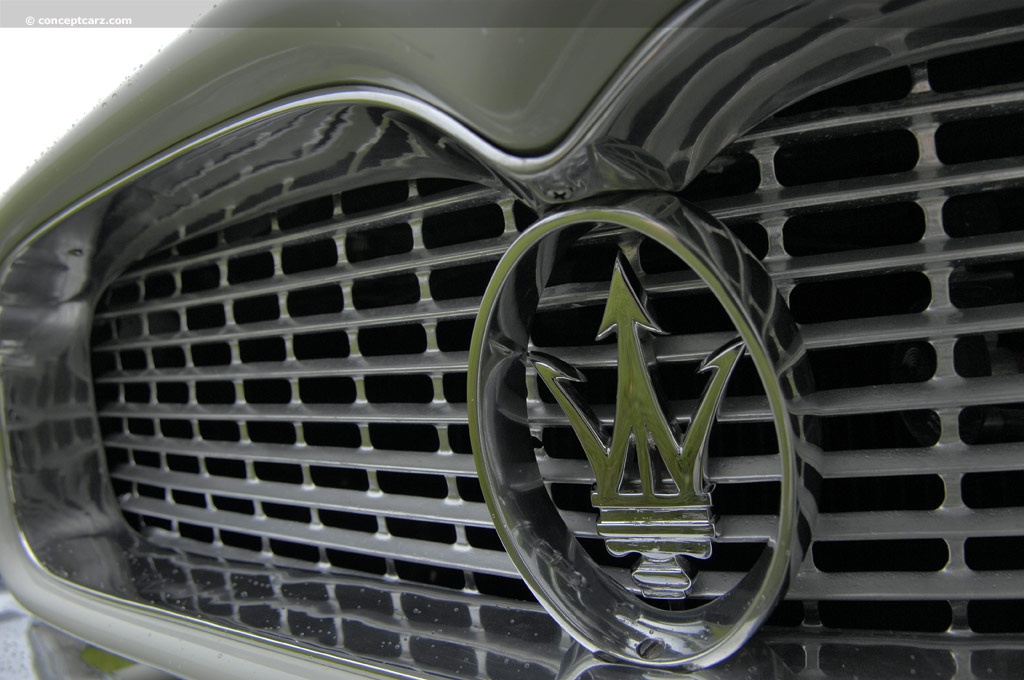
Coupe by Vignale
by Daniel Vaughan | Nov 2016
Related Reading : Maserati 3500 GT History
The Maserati 3500 GT was produced from 1957 through 1964 with over 2000 examples built. The vehicle was penned by Carrozzeria Touring gathering many styling cues from the Maserati A6G54 coupe. The 3500 GT is seen as a savior for the Maserati Company. Prior to its production, the company produced less than 140 cars in a ten-year time span. Racing and competition nearly exhausted the funds the company....
Continue Reading >>
Continue Reading >>
- 1961 Maserati 3500 GT Menu
- Article
- Image gallery
- Valuation
- Specifications
- Profiles
- Production figures
Maserati
Similar Vehicles
Similar Automakers
Similarly Sized Vehicles
from 1961
1961 Maserati 3500 GT Vehicle Profiles
Recent Vehicle Additions
Performance and Specification Comparison
Price Comparison
3500 GT Specification Comparison by Year
Year
Production
Wheelbase
Engine
Prices
Related Automotive News

Lamborghini 350 GT returns to Geneva 60 years after its debut
Automobili Lamborghini celebrates its first production model by taking it back to the city where it was unveiled in 1964 by Ferruccio Lamborghini
In March 1964, Automobili Lamborghini was still in its infancy. Established just a few months previously,...

Phenomenal Ferraris and Italian Thoroughbreds Offered at Gooding & Company's Pebble Beach Auctions
The auction house announced a stable of Italian star cars, including a 1950 Ferrari 166 MM Berlinetta Le Mans, a 1961 Ferrari 400 Superamerica Series I Coupe Aerodinamico, and a 1954 Ferrari 500 Mondial Series I Spider.
A stunning group of star...

The Best Of Lamborghini At London Concours 2020
The London Concours has announced its Great Marques Lamborghini display, celebrating the very best from SantAgata
Line-up includes icons early pioneers like the 400GT and iconic Miura, through to the Diablo SV, Murcielago and Aventador SVJ
Les...

Maserati Celebrates The 50Th Anniversary Of The First Indy Coupé Delivery
Modena, 1 July 2019 – The 1st of July 1969 is an important day in the history of Maserati, since the first Indy built for a customer left the Trident Brands historic headquarters at via Ciro Menotti 322 in Modena, heading for delivery in Switzerland....

Alpine Passion Through The Years At Retromobile
Retromobile set to play host to six classic Alpine models
The Alpine Vision show car will also be on display as a symbolic bridge between the brands past and future
Groupe Renault is pleased to confirm Alpines participation in the 42nd Retromobi...


































